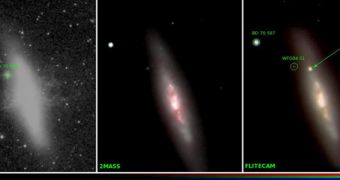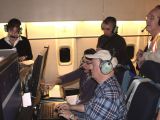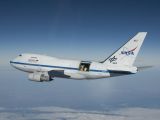Astronomers operating the NASA/DLR Stratospheric Observatory for Infrared Astronomy (SOFIA) airborne telescope used this unique asset to image the closest Type Ia supernova to occur in several decades. The event, designated SN 2014J, was observed by SOFIA during four flights in February.
SN 2014J is a type Ia supernova that occurred near the outskirts of the Messier 82 (M82) galaxy, in the constellation Ursa Major, some 11.5 million light-years away. It was detected by a British astronomy team in late January, and it has been monitored via a multitude of ground- and space-based telescopes ever since.
SOFIA joined in on the international effort with a series of four scientific flights, carried out on February 18, 20, 24, and 26. During these missions, the heavily-modified Boeing 747SP aircraft that carries the infrared instrument opened its large fuselage door, enabling the 2.5-meter (8-foot) telescope within to observe the distant cosmic blast.
SOFIA was constructed around an airborne platform in order for astronomers to conduct infrared studies in areas of our planet where such investigations are hampered by the nature of the atmosphere above. This is especially true for most of the northern hemisphere. The aircraft is capable of flying above 99 percent of Earth's atmospheric water vapors, enabling distortion-free observations.
Throughout its flights, the research team aboard SOFIA used the First Light Infrared Test Experiment CAMera (FLITECAM) instrument to observe SN 2014J. This cosmic blast is believed to have originated in a binary star system featuring at least one white dwarf-class star. Its companion may have ranged in mass anywhere from a white dwarf to a giant star several times more massive than the Sun.
“SN 2014J is the brightest and closest Type 1a supernova we've seen in the last 40 years and that's why it's exciting. We have been finishing our last instrument commissioning tests as we prepare to transition from an experimental platform into a fully operational observatory,” says expert Erick Young.
“While we were airborne, we wanted to use Supernova 2014J as a test target. We've taken some very interesting images of the exploding star, but what the scientific community wants to study most is the spectroscopic data we've obtained using […] FLITECAM,” adds the scientist, who is the science mission operations director for SOFIA.
The airborne observatory, which was developed in cooperation with the Deutsches Zentrum für Luft- und Raumfahrt (DLR), or the German Aerospace Center, is controlled from the SOFIA Science Center, at the NASA Ames Research Center in Mountain View, California.
FLITECAM observes the night sky in a near-infrared wavelength range from 1 to 5.2 microns, while also boasting spectrographic capabilities. This allows it access to infrared spectral lines inaccessible to any other space- or ground-based telescope in operation today.

 14 DAY TRIAL //
14 DAY TRIAL // 

